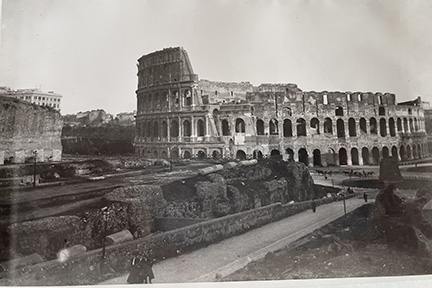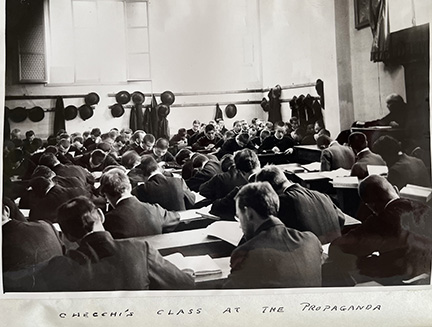From the Archives
By Mary Woodward
We left off last time with Richard Gerow, the young seminarian describing his “camarata” or cohort of classmates in Rome at the North American College.
Here is a recap: “I was assigned to a camarata composed entirely of new arrivals except for the Prefect in charge and the Beadle, the assistant Prefect. Our Prefect …was Bill Farrell – one of the older seminarians who was to be to us as a father of the family. Our Beadle …was John Hardeman of Tennessee. John knew every nook and corner in Rome.”

He goes on to identify two key classmates in the group, Samuel Stritch who would go on to become archbishop of Milwaukee and ultimately cardinal archbishop of Chicago; and James Griffin, who would become bishop of Springfield, Illinois, and a co-consecrator of Bishop Gerow in 1924 in Mobile. Members of the camarata developed lifelong friendships through the unique bond of seminary life.
In his volume of reminiscences, Bishop Gerow further chronicles his studies and daily routine as a seminarian. His room at the seminary was on the second floor overlooking the Piazza Pilotta, a smaller square in Rome, at the other end of which was the Gregorian University. Furnishings in the room included a bed, desk, chair, bookshelf, basin and pitcher, and a few odds and ends. “That was all; yet, that was sufficient to supply my simple needs,” writes Gerow.
The camarata would rise at 5:30 a.m. and be in chapel for prayer and Mass by 6 a.m. A light breakfast of Italian bread, butter and coffee was next, followed by making the bed, and at the sound of the bell heading off to the Collegio Urbano de Propaganda Fide, a Catholic seminary established in 1627 by Pope Urban VIII to train missionary priests. Familiarly known then as the Propaganda College, it is now better known as the Pontifical Urban University, or simply the Urbano.

Bishop Gerow and his cohorts would walk the six to eight-minute walk taking in the various sights and sounds of early 1900s Rome. Each day they would walk past the Trevi Fountain and other locales to get to their classes. At the Propaganda, they were joined by seminarians from all over the world, each identifiable by their uniform colors – “Greeks in blue, Armenians in black.”
To back up a little: Prior to departing from Mobile, young Gerow consulted with Mobile Bishop Edward Allen on whether he should begin theology classes or take a year to acclimate by taking philosophy classes, which he had taken at Mount St. Mary College. Bishop Allen, in his wisdom, left it up to his young seminarian to decide, and Gerow chose to acclimate in philosophy.
This decision proved very smart for him, as the classes at the Propaganda were 50-minute lectures in Latin – two in the morning and two in the afternoon. “I can readily see now the advantage of my not starting off in theology because although he speaks clearly and enunciates beautifully, yet my ear being unaccustomed in the foreign language can pick up a word or a short phrase here and there, but to follow the continued line of thought is impossible. Here is where I must make up by studying from a book the matter which he treats,” Gerow remarks.
It was at the end of the class day that the camarata would venture out to fully explore the ancient and historic sites of Rome in what was dubbed the “walk period.” Each day they would have an hour-and-a-half walk exploring the narrow cobblestone streets of the Eternal City. On free days, the walk period extended to three hours. The only requirement of the walks was that they stop in a church and spend 10 minutes praying in the Blessed Sacrament chapel.
“During my time as a student in Rome, automobiles had not yet made an appearance. … Pedestrians and donkey carts all used the same right of way. Here we meet a man carrying on his head an abundance of vegetables. There a donkey cart with boxes and other containers. …
“A little further on we notice a man carrying on his head a great load of tin ware tied together with strings. While we were looking at him the main string broke and the tin ware was seen crashing and rolling in all directions. Naturally, we expect from the ebullient Italian disposition an expression of disgust with probably a few words thrown in which are not used in polite company, but no, to our utter amazement we see him pause for a moment and then we hear from him these soothing words, ‘Pazienza, Pazienza,’ [patience, patience] as he starts to gather his fleeing pots and pans.
“Soon we come to the Tiber. This river flows in three wide curves through the heart of the city. It is crossed by many bridges affording communication between the two sides. In the olden days, this river served as a means of transporting commercial goods to and from the city of Rome. Today, however, it is not.
“Now it is time for us to make our 10-minute visit before the Blessed Sacrament, so we pick a church which we are to pass on our way home and there we make our visit.”
Bishop Gerow’s Roman adventure reminds me of my time studying in Rome, except for the no cars part. What an amazing experience for him at such a time in history!
Tune in next time for some new old adventures from the archives…
(Mary Woodward is Chancellor and Archivist for the Diocese of Jackson.)
